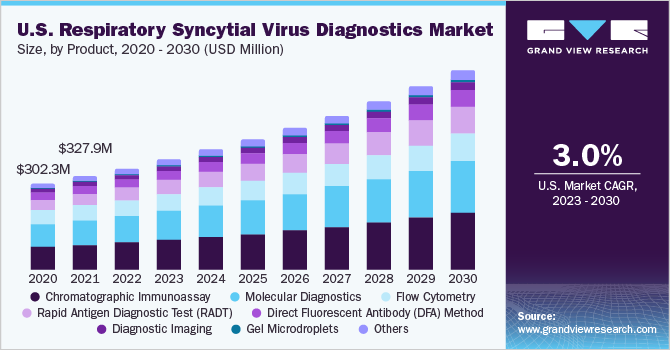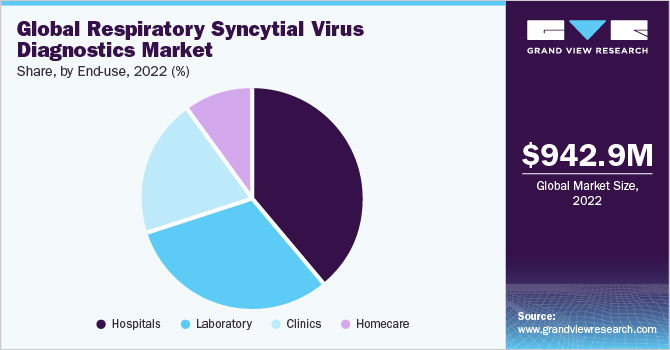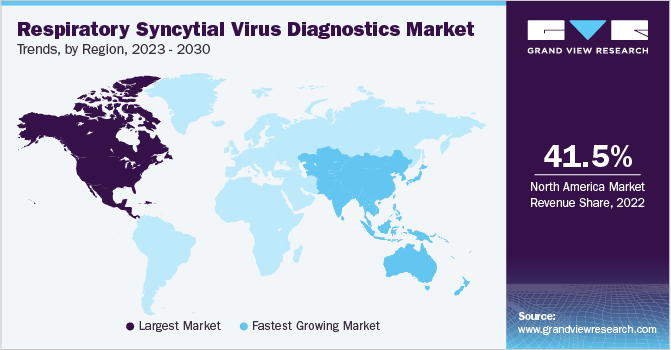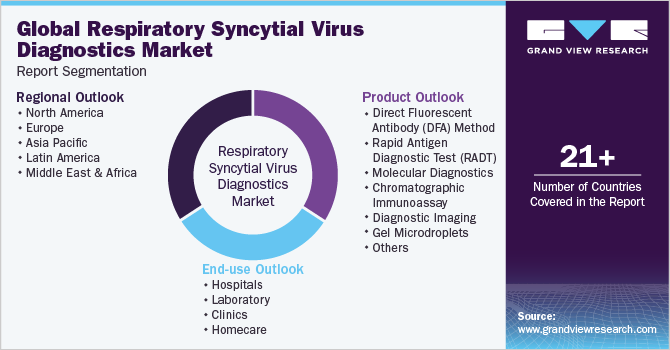- Home
- »
- Medical Devices
- »
-
Respiratory Syncytial Virus Diagnostics Market Report, 2030GVR Report cover
![Respiratory Syncytial Virus Diagnostics Market Size, Share & Trends Report]()
Respiratory Syncytial Virus Diagnostics Market Size, Share & Trends Analysis Report By Product (DFA, RADT, Molecular Diagnostics, Chromatographic Immunoassay), By End-use, By Region, And Segment Forecasts, 2023 - 2030
- Report ID: 978-1-68038-680-6
- Number of Report Pages: 118
- Format: PDF, Horizon Databook
- Historical Range: 2018 - 2021
- Forecast Period: 2023 - 2030
- Industry: Healthcare
Report Overview
The global respiratory syncytial virus diagnostics market size was estimated at USD 942.9 million in 2022 and is anticipated to grow at a compound annual growth rate (CAGR) of 9.7% from 2023 to 2030. Increasing incidence of respiratory infections, rising neonatal population base, and high demand for in-vitro diagnostics & point of care facilities are among the key factors driving the market growth. With the rising incidences of chronic conditions worldwide, cases of respiratory infections are expected to increase. In neonates, these infections are a leading cause of mortality, which can be avoided if timely diagnosis and treatments are available.

The rising frequency of respiratory syncytial virus diagnostic (RSV) disease, particularly in children under the age of two years, is driving the global market. The market is expanding favorably as a result of factors like increased infrastructure investments in the healthcare sector and parents' increasing attention to their children's health. The market development is also being positively impacted by rising knowledge of the excellent survival rates following early diagnosis and the accessibility of diagnostic tools. Favorable government initiatives, including free diagnostics, awareness campaigns, and reimbursement rules, among others, further boost the market growth.
The development of contemporary RSV detection systems, such as western blot, direct immunofluorescence, enzyme-linked immunosorbent assay (ELISA), and real-time polymerase chain reaction (PCR), is anticipated to be facilitated by the emergence of advanced techniques, such as biotechnology and nanotechnology. In addition, point of care (POC) devices and nucleic acid amplification techniques are anticipated to boost the market's growth by enabling testing with a one-step kit. Other factors influencing the growth include a rise in the number of clinical immunization studies, an increasing need for in-vitro diagnostics, a high prevalence of pediatric pneumonia, and the growing usage of molecular diagnostics.
According to the Pan American Health Organization, RSV infection cases have considerably grown across countries, such as the U.S., Canada, Mexico, Brazil, and Uruguay. In 2022, RSV circulation returned to pre-pandemic seasonal levels in most sub-regions of the Americas. To recognize a better understanding of the disease burden in various populations, without adversely affecting the current influenza surveillance network, the World Health Organisation (WHO) is focusing on integrating RSV into the existing influenza surveillance platform, the WHO Global Influenza Surveillance & Response System (GISRS).
Product Insights
Based on products, the market has been segmented into direct fluorescent antibody (DFA) method, rapid antigen diagnostic test (RADTs), molecular diagnostics, chromatographic immunoassay, diagnostic imaging, gel microdroplets, flow cytometry, and others. The chromatographic immunoassay segment accounted for the largest market share of 27.1% in 2022. It includes gravity-driven tests and oligochromatography (OC) and is used to identify and quantify the virus in a sample. The most commonly used mechanism for molecular diagnosis of RSV is Reverse Transcriptase Polymerase Chain Reaction (RT-PCR) and multiplexed nucleic acid amplification.
Rapid Antigen Diagnostic Test (RADT) is anticipated to witness lucrative growth over the forecast period owing to advantages, such as quick result time, elimination of ancillary testing, and early diagnosis & implementation of treatment. This is a point-of-care (POC) test, which can be performed in the emergency department and even in a physician’s office. In addition, this test detects infected patients early in the course of action, which leaves a positive impact on clinical decisions. In October 2021, Cepheid received the CE mark for its brand-new quick molecular diagnostic test for sale in the Europe market.
The Xpert Xpress CoV-2/Flu/RSV plus test is designed to detect viruses causing RSV infections, COVID-19, Flu A, and Flu B qualitatively from a single sample of patients. To address the difficulty of potential viral alterations in the future, the updated plus version of the test offers a third gene target for SARS-CoV-2 identification. Results from the Xpert Xpress CoV-2/Flu/RSV plus may be obtained in around 36 minutes and can be used on any of Cepheid's more than 35,000 GeneXpert Systems installed globally.
End-use Insights
On the basis of end-use, the global market is segmented into hospitals, laboratories, clinics, and homecare. The hospital segment accounted for the largest market share of around 39.2% in 2022. As the occurrence of RSV infection is prominent in neonates and infants, the treatment for these demographics is controlled with round-the-clock monitoring, and hence, there is high hospitalization in case of RSV infection.

The homecare end-use segment, on the other hand, is estimated to register the fastest growth rate of 13.3% over the forecast period. Home healthcare is a cost-effective alternative to hospital stays, which is the key factor driving the growth of this segment. Moreover, the availability of adequately trained staff for home healthcare is expected to support the growth of home healthcare during the projected period.
Regional Insights
North America dominated the global market and accounted for the largest share of 41.5% in 2022 owing to the rising incidences of these infections and an increasing infant population in the region. Molecular diagnostics and chromatographic immunoassays are the popular products used within the region as they provide high accuracy, sensitivity, and specificity. To produce companion diagnostics, an increasing number of strategic partnerships between pharmaceutical majors and in vitro diagnostic manufacturing companies is expected to make this a lucrative segment by signaling tremendous potential. Asia Pacific is expected to grow at the fastest CAGR of 11.3% during the forecast period. Strong demand for automated healthcare testing for accurate and faster diagnosis of diseases is expected to boost the market growth in the region.

China, India, Japan, and Malaysia are expected to be the fastest-growing markets in the region due to the developing healthcare systems and growing numbers of government initiatives. Furthermore, the rising infant population is expected to propel the growth of the regional market. According to UNICEF, India accounts for nearly one-fifth of the world’s annual child births with the birth of 25 million children each year. Increasing healthcare expenditure in developing countries, such as India, Bangladesh, and Malaysia, along with supportive government funding, contributes to market growth. The presence of untapped opportunities, constantly improving healthcare infrastructure, economic development, and rising patient awareness levels are also among the key factors expected to boost the market growth in the region.
Key Companies & Market Share Insights
The major players implement strategies including new product launches and mergers & acquisitions to broaden the appeal of their offerings as well as to enhance their product portfolios. For instance, in November 2021, QIAGEN introduced and obtained CE-marking for the QIAstat-Dx Respiratory 4 Plex Flu A-B/RSV/SARS-CoV-2 test. This test was designed for use with the QIAstat-Dx system and enables rapid detection of both common seasonal respiratory infections and SARS-CoV-2, providing valuable information about patients' respiratory conditions.
In September 2021, Roche introduced a collection of three PCR diagnostic test panels based on molecular polymerase chain reaction technology. These panels are specifically designed to concurrently detect and distinguish various common respiratory pathogens. The targeted respiratory illnesses encompass influenza A, influenza B and RSV, human metapneumovirus (hMPV), enterovirus/rhinovirus (EV/RV), and adenovirus (ADV). With these new respiratory test panels, Roche offers the convenience of testing for influenza and other prevalent respiratory conditions using a single nasopharyngeal swab specimen. The following are some of the major participants in the global respiratory syncytial virus diagnostics market:
-
Becton, Dickinson, and Company
-
Novartis AG
-
Abbott
-
Ortho Clinical Diagnostics
-
Thermo Fisher Scientific Inc.
-
Bio-Rad Laboratories, Inc.
-
F. Hoffmann-La Roche Ltd.
-
BIOMÉRIEUX
-
DiaSorin S.p.A.
-
Merck KGaA
-
Quidel Corporation
-
Coris BioConcept
-
Siemens Healthcare S.A.
-
Quest Diagnostics Incorporated
Respiratory Syncytial Virus Diagnostics Market Report Scope
Report Attribute
Details
Market size value in 2023
USD 1,032.1 million
Revenue forecast in 2030
USD 1,974.3 million
Growth rate
CAGR of 9.7% from 2023 to 2030
Base year for estimation
2022
Historical data
2018 - 2021
Forecast period
2023 - 2030
Report updated
September 2023
Quantitative units
Revenue in USD million and CAGR from 2023 to 2030
Report coverage
Revenue forecast, company ranking, competitive landscape, growth factors, and trends
Segments covered
Product, end-use, region
Regional scope
North America; Europe; Asia Pacific; Latin America; MEA
Country scope
U.S.; Canada; UK; Germany; France; Italy; Spain; Denmark; Sweden; Norway; Japan; China; India; Australia; South Korea; Thailand; Brazil; Mexico; Argentina; Saudi Arabia; South Africa; UAE; Kuwait
Key companies profiled
Becton, Dickinson, and Company; Novartis AG; Abbott; Ortho Clinical Diagnostics; Thermo Fisher Scientific Inc.; Bio-Rad Laboratories, Inc.; F. Hoffmann-La Roche Ltd.; BIOMÉRIEUX; DiaSorin SpA; Merck KGaA; Quidel Corp.; Coris BioConcept; Siemens Healthcare SA; Quest Diagnostics Inc.
Customization scope
Free report customization (equivalent up to 8 analyst’s working days) with purchase. Addition or alteration to country, regional & segment scope
Pricing and purchase options
Avail customized purchase options to meet your exact research needs. Explore purchase options
Global Respiratory Syncytial Virus Diagnostics Market Report Segmentation
This report forecasts revenue growth at global, regional, and country levels and provides an analysis of the latest trends in each of the sub-segments from 2018 to 2030. For this study, Grand View Research has segmented the respiratory syncytial virus diagnostics market report on the basis of product, end-use, and region:

-
Product Outlook (Revenue, USD Million, 2018 - 2030)
-
Direct Fluorescent Antibody (DFA) Method
-
Rapid Antigen Diagnostic Test (RADT)
-
Molecular Diagnostics
-
Chromatographic Immunoassay
-
Gravity Driven Test
-
Oligo chromatography (OC)
-
-
Diagnostic Imaging
-
Gel Microdroplets
-
Flow Cytometry
-
Others
-
-
End-use Outlook (Revenue, USD Million, 2018 - 2030)
-
Hospitals
-
Laboratory
-
Clinics
-
Homecare
-
-
Regional Outlook (Revenue, USD Million, 2018 - 2030)
-
North America
-
U.S.
-
Canada
-
-
Europe
-
UK
-
Germany
-
France
-
Italy
-
Spain
-
Sweden
-
Norway
-
Denmark
-
-
Asia Pacific
-
Japan
-
China
-
India
-
Australia
-
Thailand
-
South Korea
-
-
Latin America
-
Brazil
-
Mexico
-
Argentina
-
-
Middle East and Africa
-
South Africa
-
Saudi Arabia
-
UAE
-
Kuwait
-
-
Frequently Asked Questions About This Report
b. The global respiratory syncytial virus diagnostics market size was estimated at USD 942.9 million in 2022 and is expected to reach USD 1,032.1 million in 2023.
b. The global respiratory syncytial virus diagnostics market is expected to grow at a compound annual growth rate of 9.7% from 2023 to 2030 to reach USD 1,974.3 million by 2030.
b. Molecular diagnostics dominated the respiratory syncytial virus diagnostics market with a share of 26.6% in 2022. This is attributable to precise results and a rise in technological advancements in the field.
b. Some key players operating in the respiratory syncytial virus diagnostics market Becton, Dickinson and Company, Novartis Diagnostics, Abbott Laboratories, Ortho Clinical Diagnostics, Thermo Fisher Scientific Inc., Bio-Rad Laboratories Inc., Hoffmann La Roche Limited, BioMerieux, DiaSorin SPA, EMD Millipore, Quidel Corporation, Alere Inc., Coris BioConcept, Fast-track Diagnostics, and Quest Diagnostics.
b. Key factors that are driving the respiratory syncytial virus diagnostics market growth include increasing incidence rate of respiratory infections and rising incidences of chronic conditions worldwide is expected to further drive the demand for RSV diagnostics products.
Share this report with your colleague or friend.
![gvr icn]()
NEED A CUSTOM REPORT?
We can customize every report - free of charge - including purchasing stand-alone sections or country-level reports, as well as offer affordable discounts for start-ups & universities. Contact us now
![Certified Icon]()
We are GDPR and CCPA compliant! Your transaction & personal information is safe and secure. For more details, please read our privacy policy.
We are committed towards customer satisfaction, and quality service.
"The quality of research they have done for us has been excellent."





